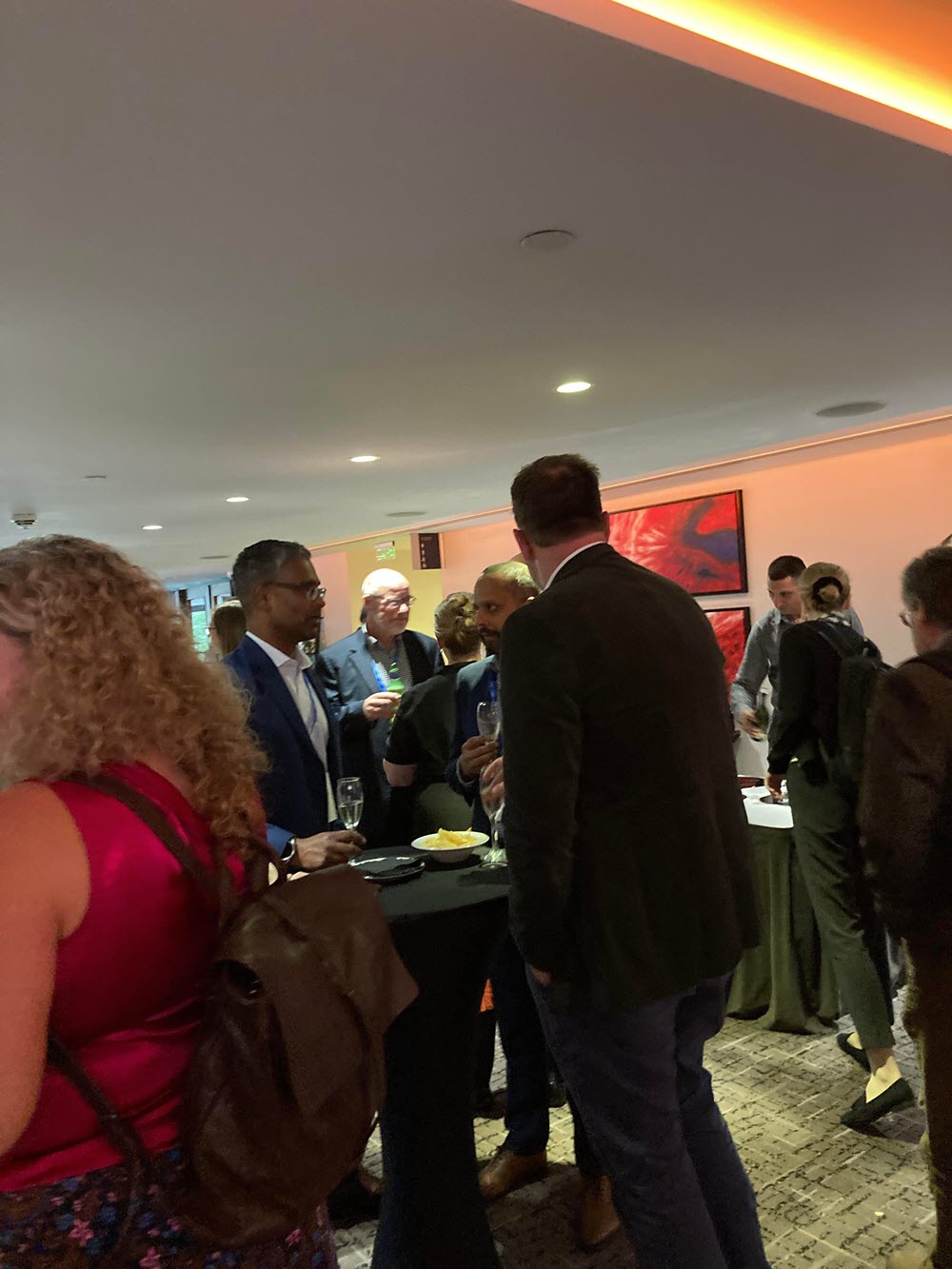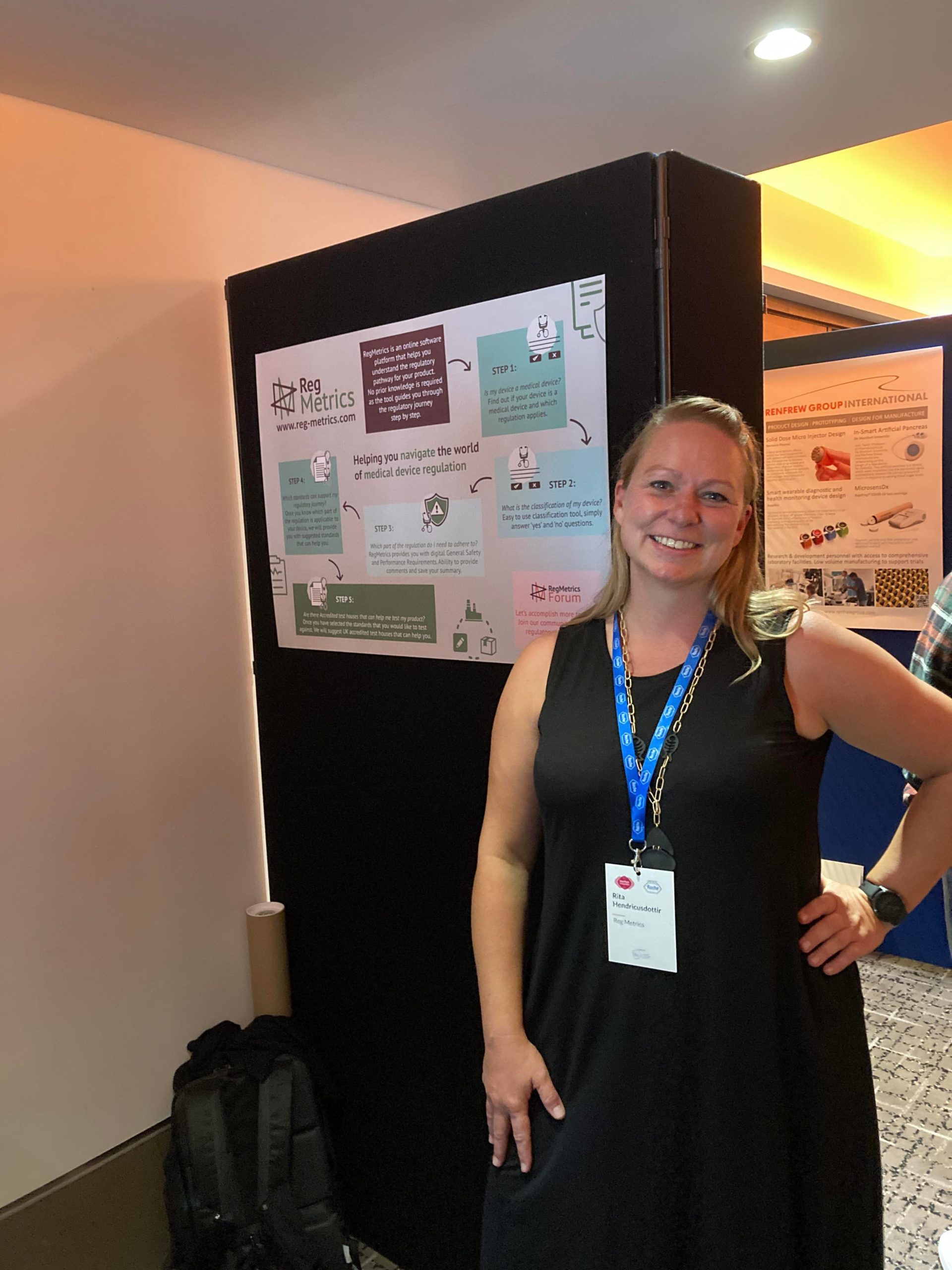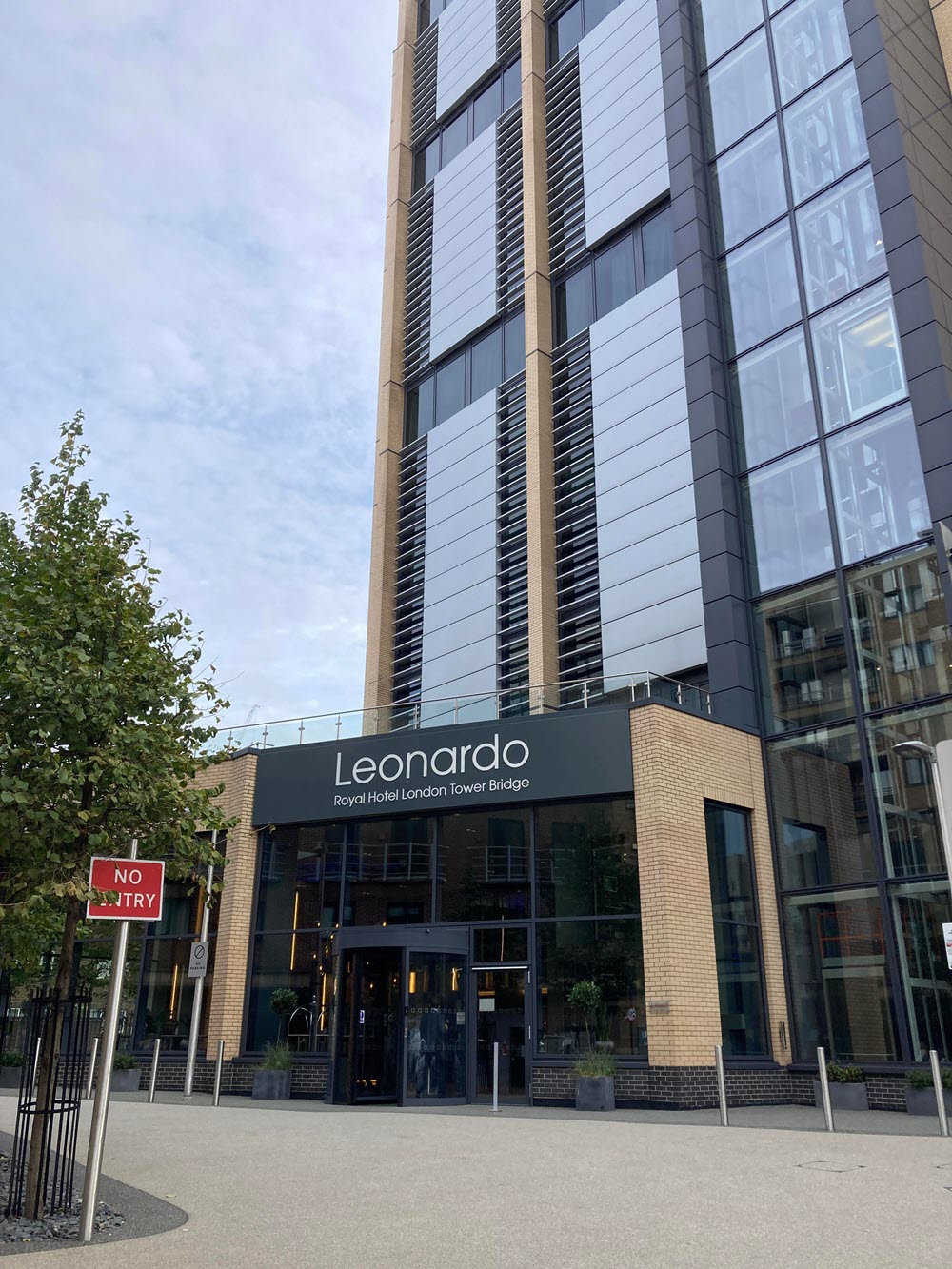
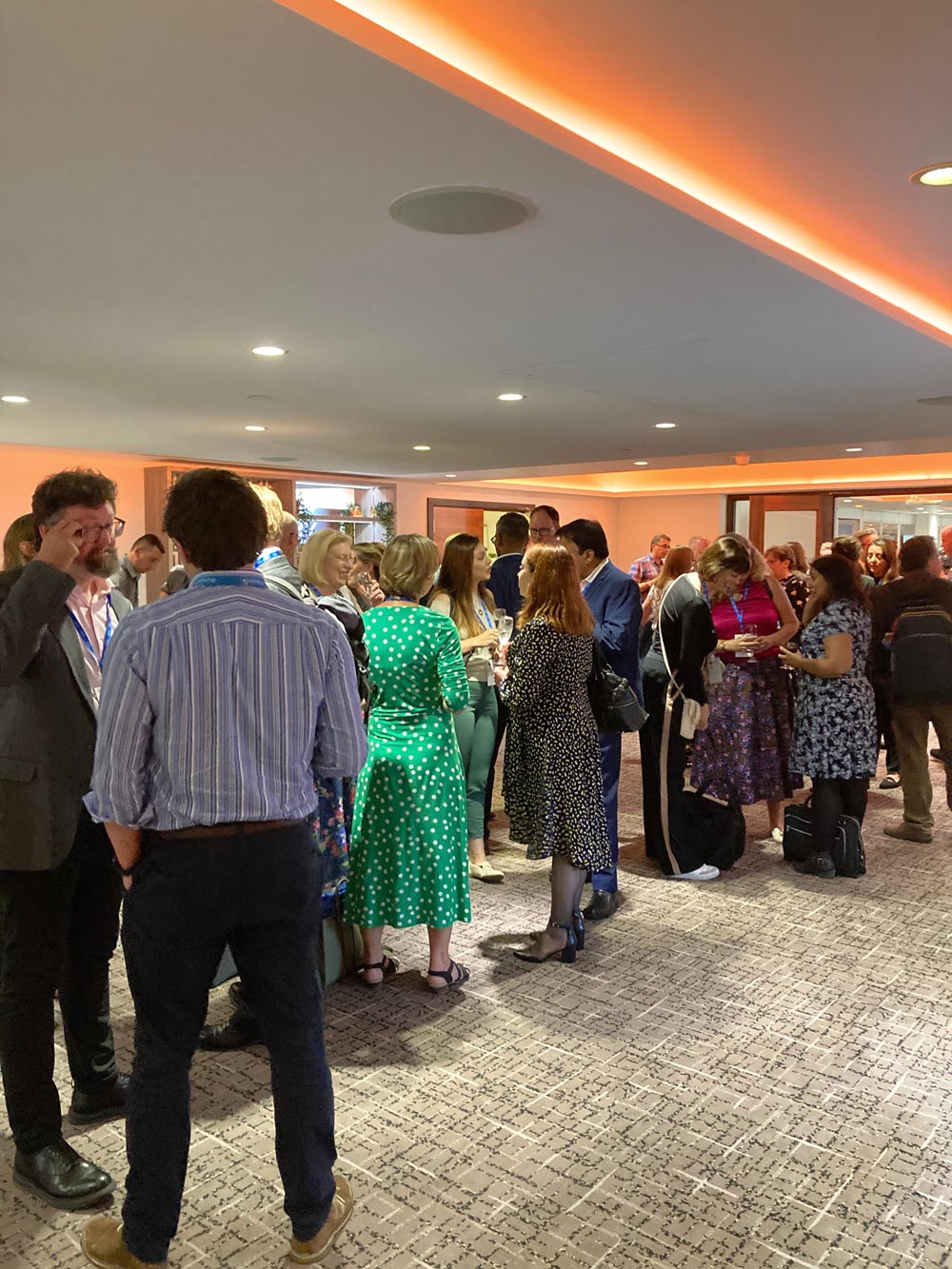
The team at Life Science Integrates were pleased to welcome 77 speakers, 12 sponsors, 17 innovators, and 347 attendees (with a further 104 joining on-demand) to the fabulous venue of the Leonardo Royal Hotel, London Tower Bridge. Given the sad circumstances of the death of Her Majesty Queen Elizabeth II, the event began with an appropriately sombre tone as Arun Harish (CPI) recognised the Queen’s ongoing appreciation of tech & innovation, with early support for the COVID-19 vaccine and a passion for sustainability. All attendees held a minute’s silence in respect.
“The future is about prevention – ‘health’ care rather than sick care”
Neil welcomed Adam Hill (CEO of Oncimmune) to the stage for an insightful conversation about MedTech’s role within our healthcare system. “Let’s not sugar coat it, the NHS is in trouble,” began Adam, describing the difficulties of a challenged and stretched health service – “my colleagues on the front line don’t have capacity to do anything more than fight fires.” But Adam inspired hope, recognising the NHS as the largest healthcare system in the world, punching above its weight in outcomes, and outlined the potential for MedTech to support the NHS in getting back on its feet and adapting to the future. “MedTech has an opportunity to do much more than it’s currently doing,” said Adam, mentioning the need for investment, fit-for-purpose regulatory systems, support for innovative SMEs, and to focus on prevention – ‘health’ care rather than sick care.
Detection, Protection & Projection
In amongst networking opportunities and innovator & sponsor exhibitions, the day featured 14 expert panel sessions centring around the three core themes of Detection, Protection, & Projection, giving speakers a platform to explore early diagnosis, effective monitoring, funding, regulations, future aspirations, and more.
Detection
“I’m a clinician. The first time I did a self-test lateral flow I got it wrong. We need to make it as user-friendly as possible”
The Detection theme began with a focus on home diagnostic testing in the ‘Make Yourself at Home’ session. Facilitator Pari Datta (Cambridge Design Partnership) reflected on the pandemic-driven progress in this field – “people became familiar with terms like PCR and lateral flow. The pandemic accelerated healthcare 2.0”. All panellists recognised the consumer demand for home testing whilst acknowledging ongoing challenges. “It’s great to have healthcare at home, but you don’t want to feel like you have a hospital at home either,” said Saif Ahmad (52 North Health), giving a clinician’s point of view of working with chronic disease patients. Simplicity was also a key theme – “if we’re empowering patients to take samples themselves, we need to make them really easy,” claimed Dean Hutchinson (Hologic Diagnostic Solutions), sharing the big company perspective. “Current regulations are not really up to it” pointed out Steve Lee (ABHI), outlining the potential minefield of understanding and measuring risk. Hamish Grierson (Thriva Health) mentioned the need for devices that encourage patients to take the tests, calling for ‘delight’ and ‘excitement’ to be incorporated into design. And, ultimately, all speakers agreed that everything must be designed around patients – “we have to listen to the customer to know what’s needed,” claimed Simon Parker (Roche).
“AI won’t be replacing clinicians but providing them with more support to make robust decisions”
AI and data analytics have a huge potential in diseases diagnosis, and this was the theme of the ‘From I to AI’ session facilitated by Stephanie Caird (Mills & Reeve). Panellists agreed that data is key, but noted issues with the current availability of data sets. “The quality of electronic data systems is variable, and there needs to be a better sharing economy around data,” explained Charlotte Barttelot (MMC Ventures). Nick Pappas (The Hartree Centre) echoed the need for better sharing: “we need effective collaboration to get meaningful results from AI.” Panellists discussed potential limits of the current IP framework – “the algorithm in healthcare needs to be effective and get the right results,” commented Stephen Hodsdon (J.A.Kemp). Looking to the future, all speakers, including Paolo Guerra (ProductLife Group) and Graham Ball (Anglia Ruskin University), agreed that we’re heading towards augmented intelligence and support for clinicians that will ultimately benefit patients: “AI won’t replace clinicians, but provide them with more support to make robust decisions,” said Anthony Finbow (Eagle Genomics).
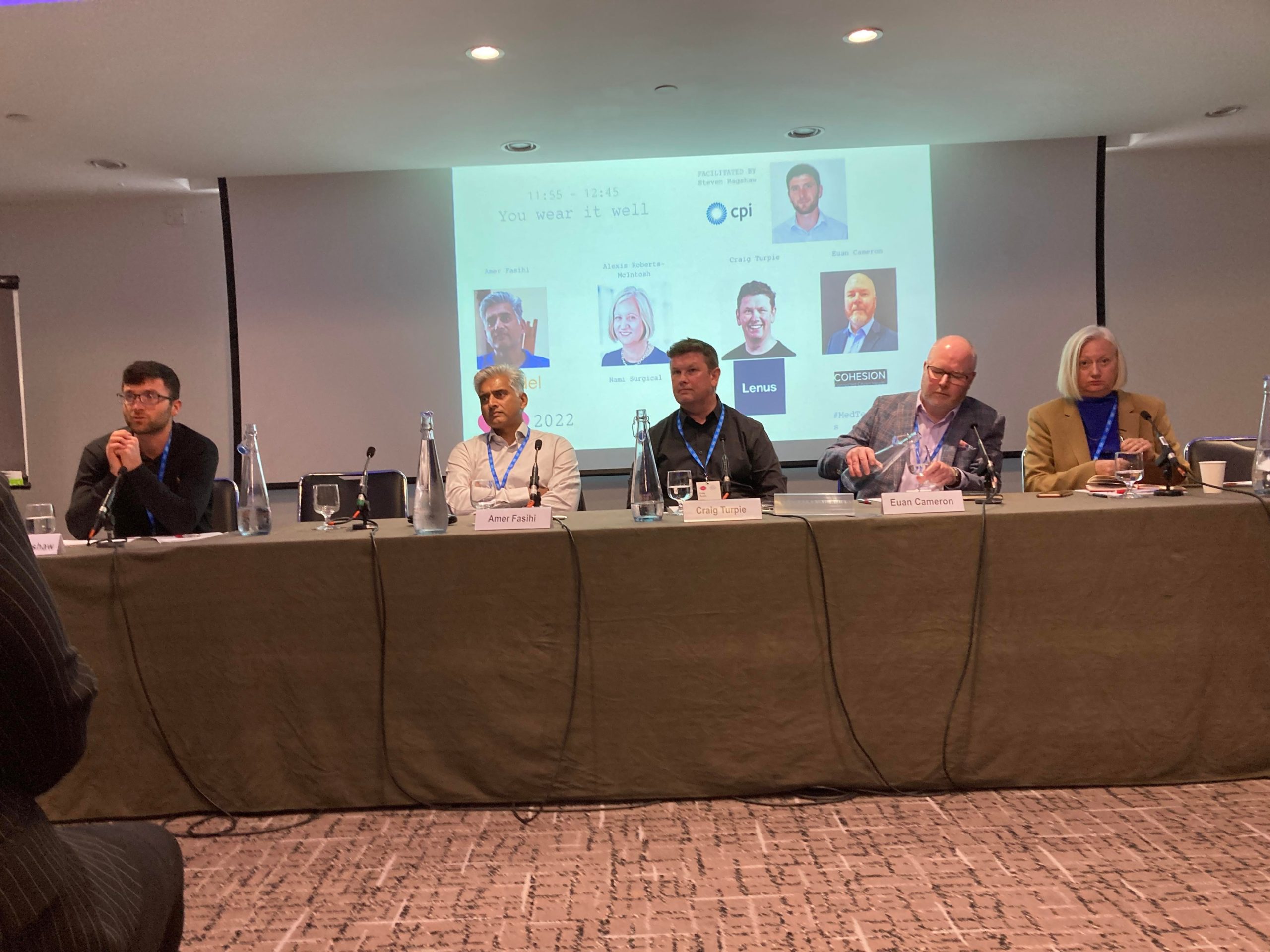
“There are so many cheap ways of addressing illnesses if you can get there early. And that’s all about having the data”
The future of the wearable device market was debated in the ‘You Wear it Well’ session led by Steven Bagshaw (CPI). Looking ahead, Alexis Roberts-McIntosh (Nami Surgical) speculated on the use of wearable devices to “monitor human performance and health in general, signposting factors that may be relevant for concern” not just for physical health, but mental health too. Panellists commented on the increased data use in our daily lives and the need for healthcare to keep pace – “huge volumes of data are being amassed outside of healthcare, so users have an increased expectation that similar data will be available within healthcare,” explained Craig Turpie (Lenus Health). Amer Fasihi (Kraydel) raised the point of quantity vs value – “it’s about the insights that come out of the data and the decisions clinicians can make.” Euan Cameron (Cohesion Medical) agreed that the “value is in the clinical decision”. Speakers considered how the UK could become a leading force in wearable devices, marking the benefits of the NHS, and praising the collaborative culture of the UK’s SMEs, academic institutes, and industry.
“In an Alzheimer’s Research UK survey, 74% said they wanted to find out so they could plan ahead”
Significant advances are being made in the early detection of Alzheimer’s and Parkinson’s disease, and this was expertly covered in the ‘Mind Over Matter’ session, facilitated by Louise Jopling (Eastern Academic Health Science Network). “Motor, neuronal, behavioural, blood biomarkers – integration’s going to be key,” explained Caroline Cake (Oxford Science Enterprises), commenting on the vast range of measures used in this field, represented by the diverse backgrounds of the panellists. Jonathan Fox (Roche) introduced the idea of blood-based biomarkers to detect people who may be at risk, whilst other panellists focused on lifestyle, behavioural and social data. “We need to appreciate how complex the brain is,” stated Euan Cameron (Cohesion Medical), “the more we can digitise, the more we can data-fy, the more we can gather information in advance, the stronger correlations we can get.” Caroline raised the important point of developing approaches to manage disease progression post-diagnosis – “eeking out every month, every year, makes a huge difference, not just to the individual, but to the whole healthcare system”. The take-home message was patient-centricity: “it’s got to be let by patients. Patients tell doctors what they find useful. The patient voice is invaluable,” commented Lucy Jung (Charco Neurotech).
Trauma, surgery & chronic conditions can cause wounds – how do we monitor them?
Facilitated by Andy Hill (NuVision Biotherapies), the ‘Just a Touch’ session explored how the pandemic has restricted opportunities for face-to-face monitoring of patients with acute or complex wounds. Panellists discussed ways to improve remote monitoring of wounds for effective care management, calling for better integration between care homes and clinicians, improved data-gathering, and greater transparency. With experience in NHS wound care, innovative technology, bioelectronics & bioresonance, and medical sales, a diverse range of perspectives were brought to the conversation by panellists Kevin Minier, (East of England Citizens’ Senate), Thariea Whisker (Healthy.io), Christopher Davies (The Hz™ Group), and Ross Robinson (PolyNovo). The discussion ended on an optimistic message of how collaboration between industry and healthcare can allow innovation to improve patient care.
Protection
‘The fast beat the slow – understand the ecosystem and your position within that’
Market access isn’t the only barrier to entry for MedTech: accessing clinicians can be just as difficult. In the ‘Access All Areas’ session facilitated by Kathryn Simpson (Kathryn Simpson Consulting), panellists discussed how to engage clinicians more readily. The key message was the importance of developing relationships and building a culture of the trust. “It’s about mutual respect for people’s time,” stated Alexis Roberts-McIntosh (Nami Surgical), “walking in the shoes of the clinician and building that individual relationship is key.” ‘Relevance’ was also a reoccurring theme – “you’ve got to make your pitch short and relevant,” stated Corrine Mossey-Gaston (Royal Papworth Hospital NHS Foundation Trust). Neil Roberts (SEHTA) agreed, explaining that “innovation needs to be meaningful and relevant. Take the time to understand clinicians’ needs.” All panellists shared tips to help small organisations cut through the complexity: “keep it simple, smaller companies have the advantage that they have fewer internal hoops to go through,” shared Tina Worth (BD).
“The whole regulatory framework has to be a part of your business model”
Led by Stephanie Caird, Mills & Reeve, the ‘Regulation, Regulation, Regulation’ session asked how best to prepare regulatory strategies for a rapid route to market. All speakers agreed that organisations should view regulations holistically, using them to focus on data quality rather than quantity. The discussion began by outlining the current challenges. “There is a changing landscape of compliance framework, but we need an all-encompassing regulatory market,” advocated Sandeep Konduru (Remcare). Steve Lee (ABHI) commented that the “biggest challenge is being able to translate the guidelines into what they mean for your project.” All speakers, including Samantha Westgate (Perfectus Biomed Group) and Nick Hex (YHEC), shared tips for MedTech companies starting out on the regulatory pathway: “think of regulation as part of the life cycle of developing and selling a product rather than a ‘cost’,” shared Phil Brown (ABHI).
“As an SME, you need to put yourself in the shoes of the funder”
Facilitated by Phil Carvil (UKRI Science & Technology Facilities Council), the ‘Money Market’ session asked how best to access grant funding. Sandra Starke (Bid/Proposal Development Manager, CPI) began by explaining the common issues she has encountered in companies making that first step to collaborate with publicly funded projects, mentioning cash-flow problems amongst very new spin-outs, and confusion over application writing amongst companies further down the line. Scott O’Brien (Innovate UK), outlined the important role of grants and loans: “it’s about trying to get the right product at the right time,” he said, explaining the importance of grants in de-risking innovation and loans in supporting later stage R&D with a route to commercial success. Michael Kipping (Element Materials Technology) shared the flaws he’s noticed in funding applications, stating that most applicants had “a really strong scientific or technical understanding of their concept, but commonly had a poor understanding of their regulatory or compliance pathway”. Andrew Barber (LCG Group) gave tips for SMEs, listing the key facets funders are looking for, including the technical competency, a valid proof of concept, regulatory experience, the clinical need, patient and public involvement aspects, appropriate project finances, intellectual property, amongst others. The discussion was complemented by first-hand insights from Jean Marc Feghali, a visually impaired PhD candidate developing novel mobility solutions with the WeWALK cane, who emphasised the importance of partnerships. Phil ended the session with a note of advice: “tap your network, do your due diligence on your investor as much as yourself, and plan out your entire journey with regulation and reimbursement pathways.”
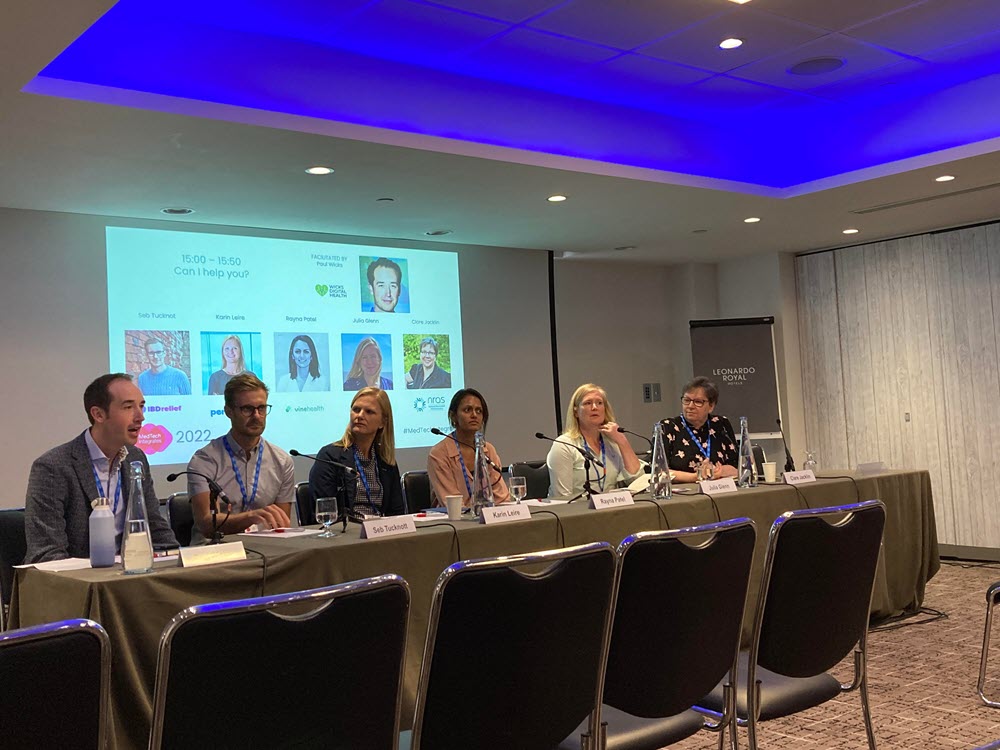
“Happy people live longer, and happy people are ill less”
Assistive technologies can transform lives, and panellists discussed whether we’re doing enough in this sector in the ‘Can I Help You’ session, facilitated by Paul Wicks (Wicks Digital Health). With speakers from organisations working with varying target users, all agreed on the importance of designing care around the citizen: “everyone has a different experience. If you design something for one patient, it might not fit for other patients,” commented Seb Tucknott (IBDrelief). Sharing a cancer care perspective, Rayna Patel (Vinehealth) pointed out the gap between what patients truly experience and what they report to clinicians – “how do you get to patients in relaxed settings, such as their homes or community, to get honest answers about their experience?” Clare Jacklin (NRAS) agreed, stating that “finding ways of gathering important data – about mood, about mental health, about emotional health – in real time will be really important.” Karin Leire from Permobil, an organisation providing powered wheelchairs, introduced the importance of user satisfaction – “we need to empower the users to get what they really need.” Julia Glenn, working on design for ageing with UKRI, agreed – “it’s not just about preventive measures and healthcare economics, but about people having fun and getting pleasure from the technology.”
Projection
Now that we’re no longer part of the EU, what are the UK’s innovation potentials?
Brexit has led to change in many sectors. In the ‘Early Doors’ session facilitated by Michael Young (Lindus Health), panellists discussed the steps the UK can take to innovate in the MedTech space. The diverse panel brought together unique perspectives from their different professional backgrounds for a well-rounded discussion. As a board-certified consultant radiologist trained in the NHS, Hugh Harvey (Hardian Health) brought an understanding of the clinician’s point of view. Regulatory insights were contributed by Tom Beale (Agilent Technology), who manages product compliance with UK and European regulations. An innovator’s perspective was added by Alex Sheppard, who is working to improve healthcare delivery models through technology with Vatic Health. And Charlotte Lee-Sinclair (Third Culture Ventures) added experience in consulting, digital health, and as an NHS-trained doctor.
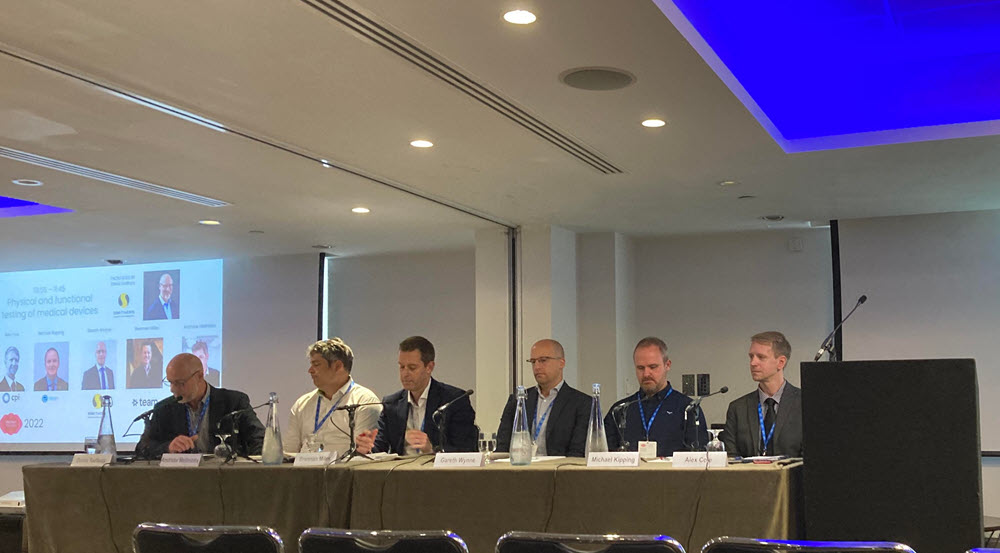
“What’s the platform? The technology? The whole device? The use indication?”
Pros and cons of using established versus unique combinational product platforms were discussed in the ‘Physical and Functional Testing of Medical Devices’ session, facilitated David Tudbury (Smithers). All panellists agreed on the importance of considering users in real-world use scenarios when designing and testing devices. “You need to define your user base – who they are, what restrictions they may have, what training they have – right from the start,” emphasised Brennan Miles (Team Consulting). “Often, people only look at the reference use-case scenario, but devices can be used in different ways,” said Andreas Meliniotis (Vectura Group), “you need to consider all the possible different use – or even miss-use – scenarios.” Gareth Wynne (Smithers) agreed, asking device manufacturers to “show me at which point the device fails” rather than how it performs in an ideal use-case. Michael Kipping (Element Materials Technology) added that regulations must take real world use into account, mentioning the importance of usability and human factor studies. The discussion covered sustainability: “it’s a huge systemic challenge,” said Alex Cole (CPI), explaining the need to streamline deliveries and re-think the possibilities of cleaning and re-using devices. Importantly, the panel emphasised the fact that each device and its users are unique: “I don’t like thinking about devices as a platform as it suggests a ‘one solution fits all’ approach which isn’t the case,” said Brennan.
“That’s where the magic happens”
In the ‘You’ve Got the Look’ session, facilitated by Meri Beckwith (Lindus Health), speakers focused on user-centred design and the importance of aesthetics in medical devices. All panellists agreed that there is no strict framework that fits all. To get the most helpful insights, patients must have the freedom to express their views and tell their own stories. With experience in cancer care, law, wound care, ostomy, Parkinson’s, pharma, and user-centricity technology, there was a great mix of experience and perspectives amongst the panellists: Umaima Ahmad (52 North Health), Toni Schneider (Ostique), Lucy Jung (Charco Neurotech), Rachel Jones (Health Unlocked) & Zan Virtnik (Parsek).
“The most carbon neutral patient is the patient that doesn’t need to be in hospital”
With 10kg of hazardous waste per patient per day, the ‘Circular Economy’ session asked how companies ensure that devices are durable and recyclable, led by Mike Lewis (Innovation Agency North West Coast). “Health and the health of our planet are interlinked,” claimed Leulla Trickett (ABHI), highlighting the importance of the issue. Panellists discussed action being taken by the industry: “we’ve started looking at our supply chain and how we move products around the world” told Michelle Sullivan (Boston Scientific), complemented by academic insights from Jonathan Cullen (University of Cambridge). However, all speakers agreed that there’s still much to do. Christopher Pomfrett (Device Access UK) mentioned the need for international collaboration, with international regulations and standards. The discussion ended with progressive future goals: “from 2035, carbon neutral products will be the only ones that can be bought by the NHS,” told Luella.
“We shouldn’t be planning for the next pandemic but rather thinking about those epidemics that spring up every year”
The Projection theme ended with the important topic of ‘Predicting the Next Pandemics’, facilitated by Beverley Vaughan, ARISE. Speakers discussed our tech and surveillance infrastructure: “we have to use AI to find that needle in a haystack when it comes to data,” said John Allan (Spatial Apps), adding that “a geo-spatial element can be useful when it comes to surveillance.” Reflecting on the COVID-19 pandemic, Beverley Isherwood (Medicines Discovery Catapult) stated that “the pandemic shone a light on the MedTech sector,” commenting on the importance of engaging with the public. Gabriella Martinez (Innovate UK KTN) touched on speed and integrity, urging that we must “ensure clinical trials can be done quickly and safely.” Looking to the future, Janet Hemingway (Infection Innovation Consortium) advocated that “we shouldn’t be planning for the next pandemic but rather thinking about those epidemics that spring up every year – we should practice what we know to dampen down epidemics and this will help us respond to pandemics.”
“Consider the SME space – there are 1000s of innovative tech companies in the UK that are a hive novel ideas”
In line with Adam Hill’s call to embrace SMEs, MedTech Integrates featured an exciting Innovator area, which provided a hub for emerging companies to present their novel products and research. With ulcer-detecting shoes for diabetes neuropathy, lab-grown lung-cells to test aerosol safety, technology to determine the correct antibiotic prescription in as little as 30 minutes, and devices to identify the exact regulations relevant to your product, there was a wealth of innovation on display. We hope all contributors made new connections that will help to take their projects forward.
From MedTech 2022 to HealthTech 2023
The team at Life Science Integrates would like to thank everyone for making the event such a success.
“After our tough decision to postpone in June, and in amongst ongoing rail strikes and the sad news of the passing of Queen Elizabeth II, we’re very grateful to everyone who has continued to support MedTech Integrates 2022, and we hope you enjoyed the event as much as we did,” said LSI Executive Director Samuel Thangiah. “We hope to see you again next year, where the event will be rebranded as HealthTech Integrates. And in the meantime, do take a look at our upcoming events: PharmaTech Integrates (22 September), AdvancedTherapies Integrates (20 October) & Pharma Integrates (17 November)” added Christopher Watt, LSI Executive Director.
All recordings from the panel sessions are available here
